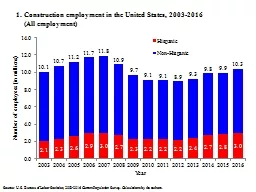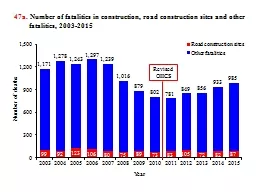PPT-1. Construction employment in the United States, 2003-2016
Author : alexa-scheidler | Published Date : 2019-12-08
1 Construction employment in the United States 20032016 All employment Source US Bureau of Labor Statistics 20032016 Current Population Survey Calculations by the
Presentation Embed Code
Download Presentation
Download Presentation The PPT/PDF document "1. Construction employment in the United..." is the property of its rightful owner. Permission is granted to download and print the materials on this website for personal, non-commercial use only, and to display it on your personal computer provided you do not modify the materials and that you retain all copyright notices contained in the materials. By downloading content from our website, you accept the terms of this agreement.
1. Construction employment in the United States, 2003-2016: Transcript
Download Rules Of Document
"1. Construction employment in the United States, 2003-2016"The content belongs to its owner. You may download and print it for personal use, without modification, and keep all copyright notices. By downloading, you agree to these terms.
Related Documents














